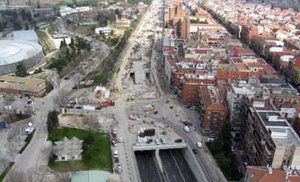

Generalities
With the improvement of construction techniques and urban development, tunnels are now built under our cities.
The most common technique of cut-and-cover is often replaced by the use of mechanized tunneling; a technique that nowadays has made possible the construction of tunnels of huge diameters up to 15 meters (Shangai and Madrid M30 tunnels).
Urban road tunnels may be used to divert traffic from center cities or to ease this traffic in the center. They are also built on some occasions to cross rivers or ports.
From a technical point of view, the construction of tunnels under the cities is particularly challenging. Due to the presence of buildings at the surface and other infrastructure in the vicinity of underground tunnels, parameters like vibrations and ground settlements must be tightly controlled. Therefore, urban tunnels are often made in soils with very low values of overburden. Risks of collapse and large deformations at the surface are very high, and negative impacts on old buildings is likely to occur if measures are not taken in advance when designing and building the tunnel.
Crossing the cities
The topography of some cities does not offer any other solutions for crossing them than going under the surface. Such is the case for coastal cities, surrounded by mountains, where virtually all the free space at the surface has been long ago occupied.
This is the case of the city of Marseille in France. A large number of tunnels enable the access by road to the city, the first one being built in 1967 , another one being an old railway tunnel converted into a road tunnel and the most recent being put in operation in 2007. Some others are still under consideration.
Another example is the city of Locarno in Switzerland, which has encountered the same type of problems due to a complex topography and where a 5.6 km long tunnel has been built. After the tunnel was put into service, around 50% of the traffic is nowadays absorbed by the new underground ring road.
On some occasions, old surface infrastructure is put underground so that new spaces can be created at the surface, creating a more environmentally friendly solution that frees space for different uses.
One example are the new tunnels created in Madrid for burying one of the main ring motorways of the city, the M30. With diameters of around 15 meters, these tunnels have been excavated in the soil by means of the biggest TBMs ever used, at the time of the construction. Nowadays, green parks and calm spaces lay where formerly thousands of vehicles went through the city.
Related cases
- Trans Tokyo Bay - Tokyo -Japan
- Boston Central Artery - Boston - USA
- M30 - Madrid -Spain
- SMART - Malaysia
Example
-
Elbe Tunnel - Hamburg - Germany
